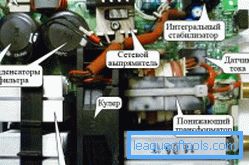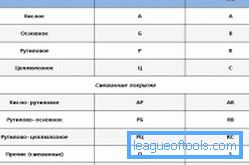Calculate the power consumption of the welding inverter
The power consumption of the welding inverter is quite simple to calculate using a simple formula. To understand all the nuances associated with the work of the welder, and aspects of calculating its power, you need to clarify a few points that everyone who is involved in welding needs to know. And no matter where you carry out welding work, at home, in the garage, in the country or in a professional team of a large shop or factory.

The device welding inverter.
Types of welding inverters
Inverter type devices are divided into three categories. Household inverters are designed for a short turn-on time and work from a single-phase AC network of 220 V. This means that it is possible to work with such a device at maximum power only for a short time - 20-30 minutes, giving it a rest equal to or exceeding this time. Semi-professional devices allow you to increase the operating time from 5 to 8 hours without a break. For semi-professional inverters, the rest time is reduced due to the design features. Professional inverters are designed for current consumption of 220/380 V, often from a three-phase network of electric current.

Modern types of welding machines.
Household, semi-professional and some professional welding units are designed for 220 V mains operation. However, it should be remembered that for household electrical networks the maximum load current cannot exceed 160 A. The power consumption of all accessories, such as sockets, plugs and power automat is not designed to exceed this threshold.
Therefore, the connection of an inverter welding machine with higher rates will either trigger an automatic switch, either cause the contact at the junction of the plug to burn out, or what is most dangerous will lead to the fading of the electrical wiring. This is contrary to all safety regulations. So, when powering a professional unit from a household electrical grid to work with a welding current of more than 160 A, be prepared for problems. But it is better not to allow this.
Back to table of contentsInverter device
The device of the welding inverter is such that at first an alternating voltage of 220 V with a frequency of 50 Hz is converted into a constant, and after that into an alternating high-frequency voltage with an operating frequency indicator of oscillation up to 200 Hz. After that, the voltage is again converted to a constant and fed to the welding arc. The quality control of the arc occurs automatically, using a microprocessor filling of the inverter control unit. Electrode stickings, which are so frequent when welding by means of a transformer, almost disappear.

Scheme of the internal device of the inverter.
For short circuits of less than 0.5 seconds, the control unit generates a sequence of short but very powerful current pulses. This leads to the destruction of the resulting bridges from the liquid metal. With a circuit of 0.5 seconds, the inverter simply turns off without freezing the electrode and not overheating the circuit of the unit. This device is basic for all types of inverters and distinguishes them from transformers and rectifiers based on a diode bridge.
The most important property of the welding inverter is energy consumption. No matter what the power consumption of the inverter-type apparatus, it is almost completely spent on welding. From this we can conclude that the efficiency of the inverter unit is very high. From 85 to 95%.
Back to table of contentsWhat you need to know?
Before you start counting the power consumption of an inverter welding machine, you need to know the following:
- Input voltage range.
- Welding current range.
- Voltage welding arc.
- Efficiency of a specific model of the welding machine.
- Duration of inclusion.
- The power factor of a particular model.

Inverter specifications
The range of welding current is needed in order to find out under what characteristics of the network of electric current we have to work. Surely it’s not a secret for anyone that often in our power supply networks the rated voltage of 220 V is not observed. Often it barely reaches 200 V. It should be remembered: the voltage sag when a household welding inverter is connected makes up 5-10% of the total network nominal. Therefore, the best power indicators will be in such inverters, which are designed for supply voltage from 150-170 V and up to 220-250 V.
The range of the welding current gives us the values of the maximum and minimum levels, the power of the apparatus directly depends on these parameters. For household inverters, these indicators in the lower boundary vary from 10 to 50 A, and in the upper 100-160 A. The output current voltage, it can also be called the arc voltage, varies for low-cost household models from 20 to 30 V. The efficiency of Inverters with a maximum output current of 160 A, as a rule, rarely exceed 0.85%. High efficiency of the welding unit depends on the duration of the inclusion.
Back to table of contentsPower calculation
The duration of the inclusion is a characteristic that shows how high-quality the device you are going to use. This is usually a percentage of the inverter’s continuous operation time relative to the total time it is used. The indicator at the level of 50% will say that when working for 2.5 minutes, the device should rest for 2.5 minutes. The lower the indicator, the longer the chains should rest and the faster the automatic overload relay triggers.
On the contrary, a high percentage will show that the apparatus can be used for quite a long time, interrupted only for the replacement of electrodes and the inspection of a weld.

The scheme of the welding inverter.
The percentage of power is calculated by dividing the time of continuous work by the sum of the time of continuous work and the pause time until the next power-up. The result is multiplied by 100. For example, the device worked properly for 3 minutes until the overheating protection worked, then it was at rest for 2 minutes, after which it was ready to work again:
3 min / (2 min + 3 min) x 100 = 60
Power factor for household or semi-professional welding machines of the inverter type rarely exceeds the threshold of 0.6-0.7. It is necessary just to remember.
All the values needed for the calculation can be easily found in the technical documentation for this device, on the manufacturer’s website or on the casing of the welding machine itself.
Imagine that, for example, we have a welding machine that is powered from an AC network of 160-220 V, having a maximum current of 160 A at a maximum voltage of the welding arc of 23 V. The efficiency of this inverter model is 0.89, and the PV indicator, on-time, makes up 60%.
Now we calculate the maximum power consumption of the inverter with the above parameters. To do this, first multiply the maximum value of the output current by the maximum output voltage. The resulting result is divided by the value of the efficiency of the device.
160 A x 23 V / 0.89 = 4135 watts
4.1 kW is the power that the device consumes directly during welding. Average power is calculated by multiplying the maximum power value by the duration of the on-time:
4135 watts x 0.6 = 2481
The average power of the inverter is the most relevant indicator, because welding usually does not occur continuously for many hours or days. There are pauses when the welder needs to change the electrode or prepare parts for subsequent processing. Often, welding can be carried out at a lower current strength indicator, in which case the total power consumed by the inverter will also decrease. Substitute in the first formula values that can be set on the console of the welding unit and find the desired power settings.
Back to table of contentsWe select electrodes

Table of the types of electrodes.
Beginner welders often have a question, what electrodes should be used for certain parameters of output current and thickness of metal?
- When the thickness of the metal is 1-4 mm, electrodes with a diameter of up to 2 mm are used. The strength of the current set at the output should be optimally chosen in the range from 20 to 90 A.
- When the thickness of the metal is 5-7 mm, electrodes are used 3 mm in diameter. The current is set in the range of 90-130 A.
- If the metal is 8–12 mm thick, 4 mm electrodes are used. Current in the range of 140-180 A.
- Metal 12-16 mm thick is welded by electrodes 5 mm in diameter with a current of 180-220 A.
- Metal thickness over 15 mm should be exposed to electrodes, ranging from 6 mm at a current of 220 A at the output of the inverter.
Metal with a thickness of more than 15 mm is better to weld using a gas welding machine.
The use of electric welding may be in this case unprofitable and costly.